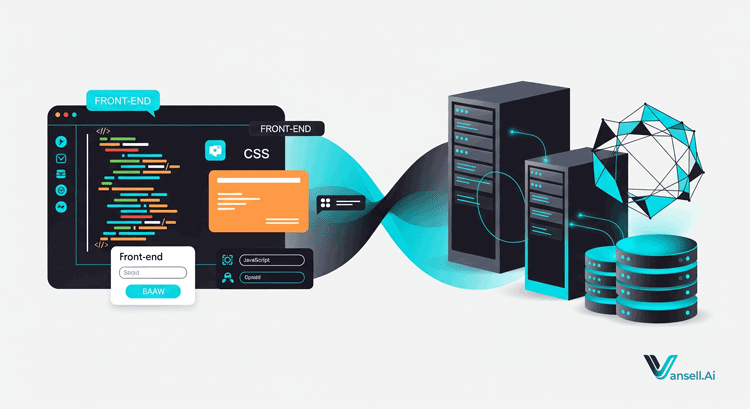Full-Stack Development: Become a Complete Developer
Learn what full-stack developers do, essential front-end and back-end skills, tools, and career strategies to build end-to-end web solutions.

- hirbodchoobak@gmail.com
- ⏱ 8 min read
Full-Stack Development: Everything You Need to Know About Being a Complete Developer
Introduction
Full-stack development has become a prized skillset in the web industry. Companies love developers who can move across the stack — from crafting pixel-perfect user interfaces to building robust server logic and managing databases. But being a true full-stack developer is more than knowing a handful of tools: it’s about system thinking, practical decision-making, and the ability to ship reliable, maintainable applications end to end. This guide will walk you through what full-stack development is, the technologies you should know, workflows and best practices, and how to map a career as a complete developer.
What Is Full-Stack Development? (Keyword: Full-Stack Development)
Full-stack development refers to building both the client-side (front-end) and server-side (back-end) of web applications. A full-stack developer understands how the entire web application works — including UI/UX, application logic, databases, servers, APIs, and deployment. This breadth helps them coordinate feature development, debug cross-layer problems faster, and contribute to product strategy.
Core responsibilities typically include:
Designing and implementing user interfaces (HTML/CSS/JS).
Building server-side logic and APIs.
Designing and managing databases.
Integrating third-party services and authentication.
Deploying and monitoring applications.
Why Companies Value Full-Stack Developers
Versatility: One developer can prototype, build, and ship end-to-end features.
Faster iteration: Fewer handoffs mean quicker implementation and less miscommunication.
Cost efficiency: Small teams or startups can move quickly without a large roster.
Better troubleshooting: Full-stack devs find root causes across the stack faster.
Product mindset: They understand business impact and build accordingly.
Front-End Skills Every Full-Stack Developer Needs (Keyword: Front-end Development)
Even as a full-stack developer, front-end expertise remains essential. You should be able to translate UI/UX into clean, accessible code.
Key front-end skills:
HTML & semantic markup: Structure content for accessibility and SEO.
CSS & layout systems: Flexbox, CSS Grid, responsive design, preprocessors (Sass).
JavaScript fundamentals: ES6+ features, asynchronous code (Promises, async/await).
Frameworks & libraries: React, Vue, or Angular — understand component architecture.
State management: Redux, MobX, Vuex, or context APIs for complex UIs.
Tooling: Bundlers (Webpack, Vite), package managers (npm/yarn), linters.
Accessibility & performance: ARIA, keyboard navigation, image optimization, lazy loading.
Best practice: Always start with a mobile-first approach and ensure cross-browser compatibility.
Back-End Skills and Core Concepts (Keyword: Back-end Development)
On the back end, you’re responsible for application logic, databases, and infrastructure.
Key back-end skills:
Server languages / runtimes: Node.js (JavaScript), Python (Django/Flask), Ruby (Rails), Java (Spring), PHP (Laravel).
Databases: Relational (PostgreSQL, MySQL) and NoSQL (MongoDB, Redis).
API design: RESTful services, GraphQL for flexible client queries.
Authentication & security: JWT, OAuth, input validation, encryption, OWASP awareness.
Caching & performance: Redis, CDN usage, query optimization.
Message queues: RabbitMQ, Kafka for async processing.
Cloud & hosting: AWS, Azure, Google Cloud, serverless architectures (Lambda, Cloud Functions).
Best practice: Design APIs with versioning and clear contracts (documentation), and instrument logging and monitoring from the start.
Full-Stack Tooling and Frameworks to Learn (Keyword: Full-Stack Tools)
The modern full-stack toolkit includes frameworks and developer tools that speed up development while enforcing structure.
Recommended stack combos:
JavaScript stack (MERN / MEVN): MongoDB + Express + React/Vue + Node.js. Great for JS-centric teams.
Jamstack approach: Static site generators (Next.js, Nuxt) + APIs, ideal for performance and security.
Python stack: Django/Flask + PostgreSQL for rapid development and a rich ecosystem.
Serverless: Cloud Functions + managed databases for variable workloads.
Dev tools: Git + GitHub/GitLab, Docker, CI/CD (GitHub Actions, GitLab CI), Terraform for infra as code, and observability tools (Prometheus, Grafana, Sentry).
How a Full-Stack Workflow Typically Looks (Keyword: Full-Stack Workflow)
Requirement & design: Convert product needs into UI wireframes and API contracts.
Prototype: Build a minimal front-end prototype or API stub.
Implement back end: Create data models, business logic, and API endpoints.
Integrate front end: Connect UI to APIs, handle errors and loading states.
Test: Unit tests, integration tests, end-to-end tests (Cypress, Playwright).
Deploy & monitor: Use CI/CD pipelines; monitor logs and performance metrics.
Iterate: Use analytics and user feedback to refine features.
Tip: Use feature flags to release safely and rollback quickly if needed.
Best Practices for Full-Stack Development (Keyword: Full-Stack Best Practices)
Separation of concerns: Keep UI, business logic, and data access clearly separated.
API first design: Define APIs early so front-end and back-end can progress in parallel.
Automated testing: Unit tests, API contract tests, and regression testing reduce bugs.
CI/CD pipelines: Automate builds, tests, and deployments to reduce manual errors.
Security by design: Use HTTPS, sanitize inputs, enforce least privilege.
Scalability planning: Design services that can scale horizontally and use caching wisely.
Documentation: Maintain README files, API docs (OpenAPI/Swagger), and architectural diagrams.
Common Challenges for Full-Stack Developers and How to Overcome Them
Challenge: Context switching between front-end and back-end slows productivity.
Solution: Block time, use clear checklists, and modularize work to reduce cognitive load.
Challenge: Keeping up with rapid toolchain evolution.
Solution: Focus on fundamentals (HTTP, SQL, JavaScript) — frameworks will change, fundamentals endure.
Challenge: Overengineering small projects.
Solution: Start with simple architecture and evolve as real constraints appear.
Career Paths: From Junior to Senior Full-Stack Developer
Junior Full-Stack: Learn basics of both front and back end; ship small features; learn Git and debugging.
Mid-Level: Take ownership of features, design APIs, optimize performance, mentor juniors.
Senior / Lead: Architect systems, design scalable solutions, lead teams, and translate business requirements into technical roadmaps.
Alternative paths: Move into DevOps, Product Engineering, Technical Product Manager, or Founding CTO for startups.
Skills to develop for advancement: System design, leadership, code reviews, performance engineering, and stakeholder communication.
How to Learn Full-Stack Development Efficiently
Build projects: Real projects beat tutorials — build a CRUD app, blog, or e-commerce prototype.
Read source & docs: Study framework docs and key open-source projects.
Use online courses & bootcamps: Focused programs speed learning but apply knowledge immediately.
Contribute to open source: Gain experience reading and improving real codebases.
Pair programming & mentorship: Learn patterns and workflows faster with peers.
When to Use a Full-Stack Developer vs Specialized Teams
Use a full-stack dev for prototypes, small teams, MVPs, and startups where speed and flexibility matter.
Use specialized teams (separate front-end, back-end, ops) for large enterprises where scale, reliability, and specialization are key.
Choosing the right model depends on project complexity, timeline, and budget.
Conclusion — Becoming a Confident Full-Stack Developer
Full-stack development is about balance: a mix of craftsmanship, systems thinking, and practical tools. The modern full-stack developer can accelerate product development, reduce communication friction, and build holistic solutions that meet business needs. Start by mastering core front-end and back-end concepts, pick a practical stack, build real projects, and iterate with tests and deployment automation. Over time, broaden into architecture and leadership to maximize your impact.
Call to action: Ready to build your first full-stack project? Start with a simple MERN or Jamstack prototype today — and if you want a tailored learning path or project review, I can help you design one. Tell me which stack you prefer and I’ll create a step-by-step roadmap.https://vansell.ai/web-development

